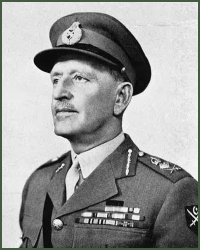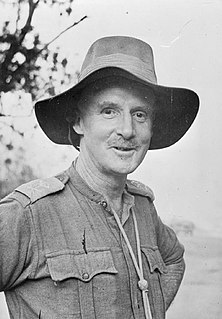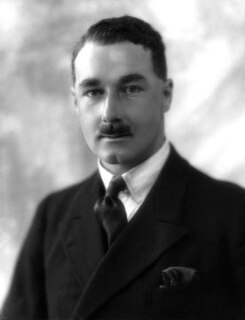
Lieutenant General Walter David Alexander Lentaigne,, also known as Joe Lentaigne, was a senior officer in the British Indian Army.
Lieutenant-General Sir (Donald) Kenneth McLeod was a British Indian Army officer.

Sir Thomas Jacomb Hutton, KCB, KCIE, MC & bar was a British Army officer who held a variety of vital staff appointments between World War I and World War II, ultimately commanding the Burma Army during the early stages of the Japanese conquest of Burma in early 1942.

General Sir Douglas David Gracey & Bar was a British Indian Army officer who fought in both the First and Second World Wars. He also fought in French Indochina and was the second Commander-in-Chief of the Pakistan Army. Gracey held this latter office from 11 February 1948 until his retirement on 16 January 1951. Born to English parents living in India, he was educated in English schools before returning to India to serve in the military there.

General Sir Frank Walter Messervy, was a British Indian Army officer in the First and Second World Wars. Following its independence, he was the first Commander-in-Chief of the Pakistan Army. Previously, he had served as General Officer Commanding-in-Chief Northern Command, India in 1946 and 1947.
Lieutenant General Sir Lewis Macclesfield Heath, was an officer in the British Indian Army during the early to mid-twentieth century.
Lieutenant-General Sir Harold Rawdon Briggs, was a senior British Indian Army officer, active during World War I and World War II and the post-war era.

Major General Thomas Wynford Rees was an officer in the British Indian Army during World War I, the interwar years, World War II, and after it.

The 25th Indian Infantry Division was an infantry division of the Indian Army during World War II which fought in the Burma Campaign. It was re-raised within the post-independence Indian Army in 1948.
Lieutenant General Sir Reginald Arthur Savory (1894–1980) was a British Indian Army officer during World War I and World War II.
Major-General William Alfred Dimoline CB CMG CBE DSO MC was a senior British Army officer who saw service during World War I and World War II. His nickname was "Dimmy."
Lieutenant General Sir John Fullerton Evetts CB, CBE, MC was a senior British Army officer.
Brigadier John Hume Prendergast DSO MC & Bar was a British Indian Army, and later British Army, officer and travel writer.

The Japanese invasion of Burma was the opening phase of the Burma campaign in the South-East Asian theatre of World War II, which took place over four years from 1942 to 1945. During the first year of the campaign, the Japanese Army drove British Empire and Chinese forces out of Burma, then began the Japanese occupation of Burma and formed a nominally independent Burmese administrative government.

The Burma campaign in the South-East Asian Theatre of World War II took place over four years from 1942 to 1945. During the first year of the campaign, the Imperial Japanese Army with aid from Burmese insurgents had driven British forces and Chinese forces out of Burma, and occupied most of the country. From May to December 1942, most active campaigning ceased as the monsoon rains made tactical movement almost impossible in the forested and mountainous border between India and Burma, and both the Allies and Japanese faced severe logistical constraints.

General Satyawant Mallanna Shrinagesh was an Indian military officer who served as 3rd Chief of Army Staff of the Indian Army from 14 May 1955 till 7 May 1957. After retirement he served as the Governor of Assam from 14 October 1959 to 12 November 1960 and again from 13 January 1961 to 7 September 1962. He was the Governor of Andhra Pradesh from 8 September 1962 to 4 May 1964 and Governor of Mysore from 4 May 1964 to 2 April 1965. He also served as principal of the Administrative Staff College of India in Hyderabad, Hyderabad State from 1957 to 1959.

Major General David Tennant Cowan CB, CBE, DSO & Bar, MC, also known as "Punch" Cowan, was an officer in the British Army and British Indian Army in World War I and World War II. He was distinguished for leading the Indian 17th Infantry Division during almost the entire Burma Campaign.

Southern Command is a formation of the Indian Army, active since 1895. It has seen action during the integration of several Princely States into modern India, during the 1961 Indian Annexation of Goa, and during the 1965 and 1971 Indo-Pakistani Wars. Lieutenant General Jai Singh Nain is the current Southern Army Commander.

The Northern Command is a Command of the Indian Army. It was originally formed as a formation of the British Indian Army in 1895, scrapped upon India's independence in 1947 and later reformed in 1972. Its present commander is Lieutenant General Yogesh Kumar Joshi.

Major General Lechmere Cay Thomas, was a senior British Army officer who fought in both the First and Second World Wars.












